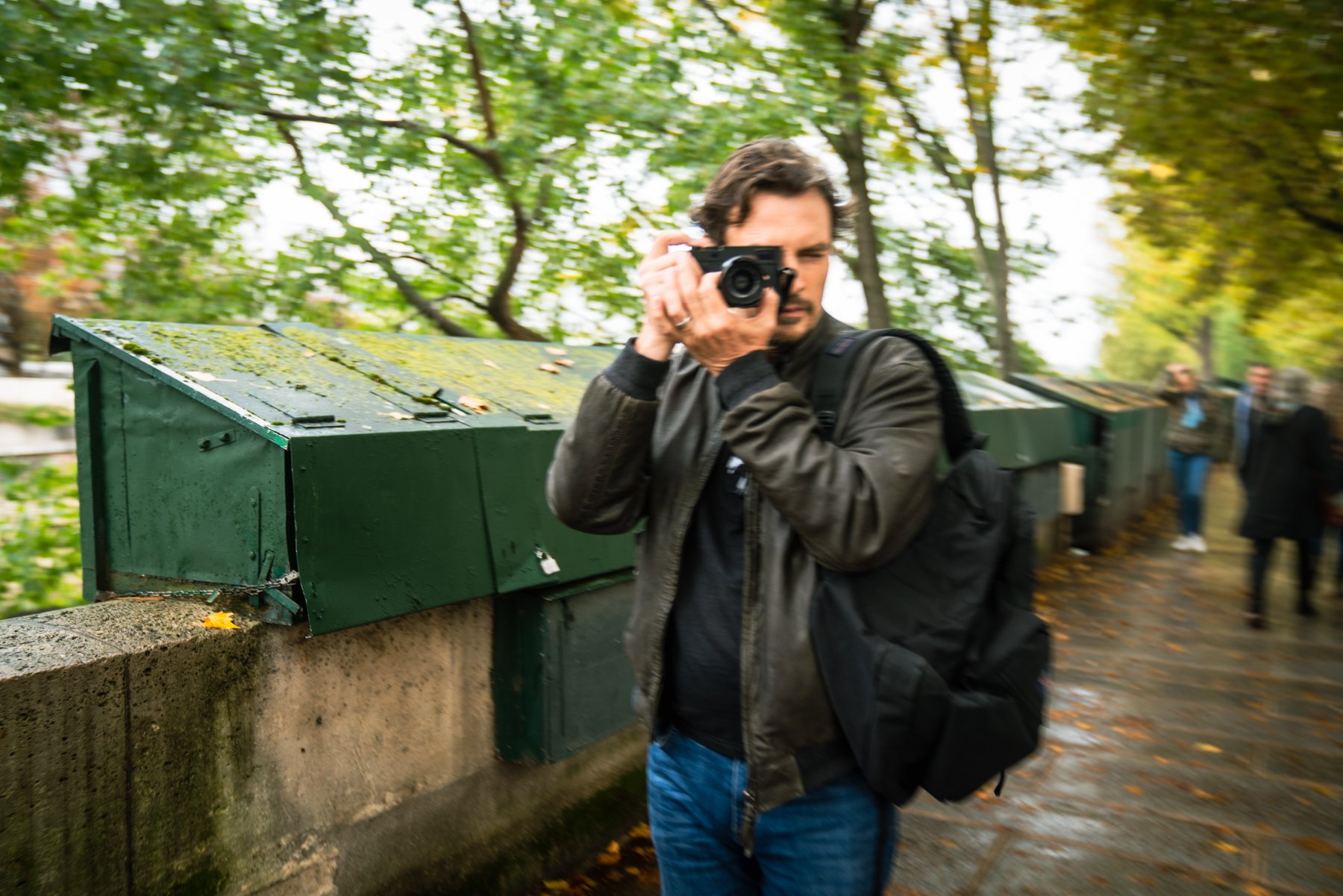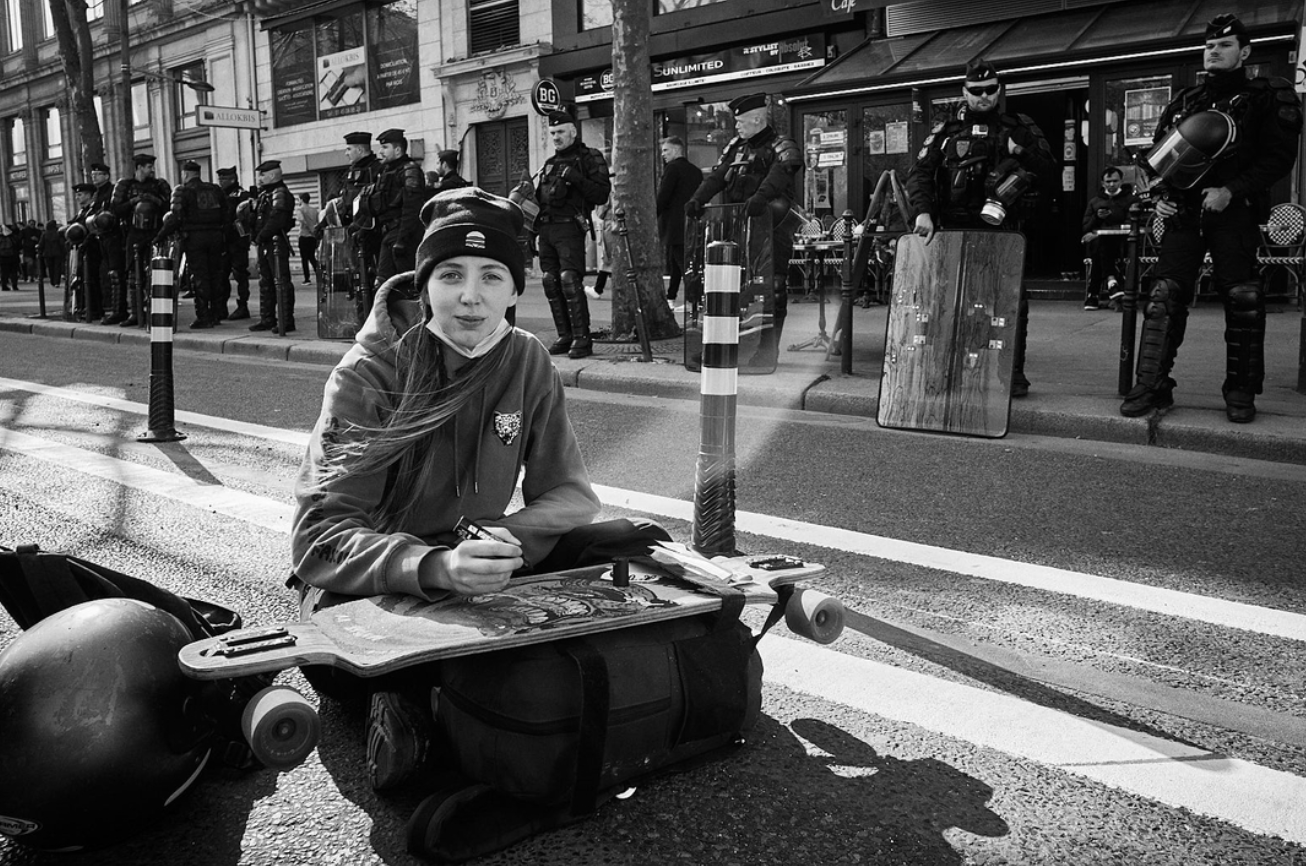Behind the Lens
Why I choose Leica
Let’s agree that a camera is just a tool to create an image. There are many, and their strengths differ. Some feel good in my hand and not so good in yours. The camera (tool) you choose is a personal choice and as long as it gets you what you want then it’s silly to argue against it.
With that out of the way I’ll explain my personal choice for those that are looking to buy into rangefinders in general and Leicas more specifically. I’ll go point by point but in no specific order. First, I use Leica M’s for my street photography. I have an M3 from the late 1950’s which I don’t use nearly as much anymore due to the outrageous cost of film and the subsequent costs in time and money of the development and scanning. I love film (I started when it was the only option) but I use it rarely these days. I also have an M10P and an M10 Monochrom.
The rangefinder experience is really the make or break feature of the Leica M’s. Looking through the viewfinder is nothing at all like SLR’s or modern mirrorless cameras. What you see is not what you get. No matter what lens you put on the camera, the view doesn’t change. It’s the same whether or not it's a 21mm or a 135mm lens. In order to frame your subject correctly, a set of framelines appears in the viewfinder that corresponds to the lens you have mounted. Why I like that is that it allows you to see more than your lens sees and therefore allows you to see what’s happening just outside of the frame. It helps to anticipate action. You know if someone or something is about to enter and you can anticipate where in the image you want that subject to be before you activate the shutter. The performance cost of course is that since you are using just a portion of the finder for the lens, the frame lines are smaller for each progressively larger focal length. It gets pretty small when you are at the far end of the built in lens frame spectrum (135mm). If I were using long lenses a lot then I likely wouldn’t be in love with rangefinder based cameras.
My favorite part of the rangefinder window, which can be found similarly in the Fuji x100 and XPRO series is that everything appears in focus regardless of whether or not the lens is actually focused and it doesn’t indicate the depth of field in any way. Why this is a benefit is that it really makes you take notice of your composition. With an SLR you typically see the view as if it were at maximum aperture and depending on the subject, and the lens choice (everyone lusts after the widest apertures in order to blowout any and all backgrounds and therefore not really worry about what’s in the scene. It’s an easy trick. It’s also a potentially boring trap that I fell into for a really long time. It’s a one trick pony as they say. When you start to compose as if everything is there and in focus then you start to choose more interesting/more complex compositions and your choice of aperture becomes an additional component to your image and not the sole determining factor that it so often seems is the case with so many photographers. To throw myself into the mix, one of my best friends used to joke with me and remind me that there were other aperture choices on my lens. I left it open wide all the time. I feel personally that once I learned to compose as if everything were visible and focused I became a better photographer. It opened a new compositional realm to me. As an illustration to the point (not me becoming better), if you look back at the most famous photos in history and nearly all Pulitzer prize winning photos, very few out of the overall group were shot wide open. There is a great amount of depth of field. The compositions were carefully chosen and the resulting images went on to be remembered by us all. That doesn’t mean everything has to be shot at f8 or higher. It just means that even the softer focused parts of the image will be arranged more carefully and contribute when possible.
Now as far as focussing goes, it just takes getting used to. It’s manual as I mentioned earlier. In the center of the viewfinder there is a small rectangular patch which is brighter than the rest of the window. In order to focus, you place the bright patch on the object you want to focus on. As you turn the focusing ring, you’ll begin to see a ghost image of what you are trying to focus on and start moving toward the center of the patch. To achieve focus, you place the ghost image on top of the object you are focusing on until the two appear sharp and perfectly lined up with each other. It gets easy with practice. A serious benefit with this method of focussing is how low the light can be and you can still focus with no problem. I’ve quickly focused a Leica in a dark room that gave my auto focus Sony A73 trouble (with a fast lens).
Another thing that isn’t a benefit or a feature but is real none the less is how good they look and feel. There is something that goes even beyond that. Something that just calls to you to use one. To carry it everywhere while your lage lensed dSLR or simple SLR for that matter, stay at home, in the bag. Part of it of course has to be the history of them. The amazing photographs made by historic photographers in all kinds of situations and various genres. If they did it, I want to as well. I’ll reiterate what I said in the beginning, cameras are tools. I choose to use the one that makes me happy. I can get results out of lots of different cameras. There is no perfect camera, just the camera that’s perfect for you. For me that’s my Leica(s). For others it is not and I am happy if they are happy.
Regardless of the system you are thinking of switching from or adding to, there is a learning curve. It requires more thought and in the beginning that will hinder you. Like driving a car. Until you've got some miles out of it you're not really comfortable and therefore you can’t get the best performance out of it. Use it awhile and without really noticing, you start to do things more intuitively and suddenly the performance potential is realized and you are not looking back.
I get nothing for saying any of this other than satisfaction if it helps anyone make a decision one way or the other. If you have any questions, feel free to ask. I’m happy to share what I’ve learned over the course of a long life and career with cameras.
Favorite Photography Galleries in Paris
There are so many great photo galleries in Paris and an incredible amount of other options to view photography including museums, hotel lobbies and pop up spaces around the city.
I’ve narrowed it down to tell you my favorite five. I’d say no particular order but I would be lying, MEP is hands down my favorite.
The first 3 in the list charge admission and the last two are free.
Maison Européenne de la Photographie [MEP]
5/7 Rue de Fourcy
75004 Paris
Fondation Henri Cartier-Bresson
79 Rue des Archives
75003 Paris
Cour de Venise, 12 Rue Saint-Gilles
75003 Paris
6 Rue de Seine
75006 Paris
3, Rue du Pont Louis-Philippe
75004 Paris
Why I use Leica
First things first. A camera is a tool. A particular camera doesn’t make you a better photographer just by using it.
I do think certain aspects of various cameras provide benefits for the photographer using them but only if you actually need it. For instance, great low light ability is wonderful for me but fairly useless for someone who has chosen to only shoot landscapes in the daylight.
Now with that out of the way, let me tell you a story.
I’ve been photographing since I was a kid. I’ve been a professional photographer since maybe my early/mid 20’s back in the 90’s. I started with Pentax, moved to Canon for a long time and then switched to Sony for technical reasons at the time which have now been addressed by Canon (too late for me though).
For most of my adult life I’ve been drawn to the masters of street and documentary photography. Many (not all) used Leica rangefinder cameras for their work. It piqued my interest but I was happy with my camera(s) and I couldn’t justify the price for what I was doing (and getting paid at the time).
I began shooting more street photography as personal work to keep my head clear and my love of photography intact. With that, I began to crave a Leica again.
This time I had more reason but I still wasn’t being paid for it. It was personal.
I found a wonderful alternative. I bought a brand new Zeiss Ikon and a 50mm lens (which happens to have the same mount as the Leica M). It was great. I learned everything I needed to know about rangefinders and I didn’t break the bank.
That said, I still kept looking at Leicas. One day in a camera store in Scottsdale, AZ I had my Ikon over my shoulder and struck up a conversation with a photographer who worked there. He had an M6 and wondered why I had bought a new Zeiss. I told him all the wonderful things about my new love and he told me, you're going to buy a Leica eventually so why not start now (he wasn’t trying to sell me one either).
I think I told him he was wrong and that I’m more pragmatic. He was right though. There is something magical (because I can’t fully explain it) about a Leica M. From the look to the feel and of course the lineage.
Would the old masters that I looked up to use one now when there are so many choices? Who knows. They would use whatever made them happy the same way that I do.
I have used many different systems and shot all sorts of things in my lifetime. I have bonded with many cameras and not others (I’m looking at you Sony) but nothing has really ever made me just feel as happy to hold (talking cameras here) as a Leica.
I have 3 at the moment, an M3, M10P and an M10M. I don’t see needing another for a long time (or ever) since they are so good now and built so well. Who knows though. They are like beautiful watches and cool old cars. I’m not a collector of anything. I only buy things I want to use. I use the M10s daily. More than any camera I’ve ever had. One of them is with me everywhere.
Using a slow shutter speed…
Using a slow shutter speed to capture movement. Everyday street photography, me walking my hometown streets of Montpellier France.
This photo is some peak action skateboarding fun. This was shot after I left the really nice, main branch of the Montpellier library with a few really good monographs featuring, Cartier-Bresson, Elliot Erwitt, Sergio Larrain and Peter Lindburgh.
There are always (at least when I've been there) skaters in the space between the library and the amazing public pool.
A note about the shot for those that may wonder how it's done in camera.
Focus is set ahead of time. Use a slow shutter speed and follow the action. Trigger the shutter and continue your follow through. The follow through portion is more important than it sounds.
Trial and error is your friend here. The slower the shutter the more surrealistic and unexpected (and many unusable) images you get.
It's a risk, reward thing so start on something unimportant.
I've been doing it for years and it's a trick I go to fairly often when the situation is right.
Keep playing and never stop learning.
Street Photography Ethics (mine anyway!)
I present a lesson on what I see as street photography ethics (just one of many ethical points in the genre I might add and a full on topic in my upcoming street photography course in May). Ethics and adherence to them vary of course. That said, let's begin.
I present a lesson on what I see as street photography ethics (just one of many ethical points in the genre I might add and a full on topic in my upcoming street photography course in May). Ethics and adherence to them vary of course. That said, let's begin.
What about this shot makes me think of ethics?
It's the bottle next to this photogenic man.
Would removing it make for a better image? Uncertain. Possible.
Could I have moved? Yes (but the light was perfect for here and I like the background).
Could I have moved the bottle? Possibly, but that would require way to much scenic manipulation for my taste and the possibility of the gentleman just saying no for something that isn't important.
I could have moved in and cropped tighter except that I like(d) the extra context of his environment with this crop.
Could I just remove it in post? Absolutely not! Not in my ethical model anyway. To remove something by way of editing software or any other means (other than cropping) is changing the reality of the moment and therefore creates something that never really existed. That goes against everything I believe in street and documentary photography.
If you are creating images as fine art and don't really care about the reality of the moment then feel free to do what you wish. I choose to let things remain as they are and work with or around them.
Cropping isn't unethical as it doesn't change anything. It simply acts the same as moving closer or farther back. You can crop in camera or in post and the basic effect is the same (differences due to perspective perhaps but no manipulation of reality).
The bottle in question was his and as such can be a part of his story (whatever story that is).
Leave it, crop it or move on to the next pic and count this as one of the many that just wasn't good enough to show. The choice is yours.
Over the years, countless images have gone unseen because of something I could change. That's just how it is.
Paris Street Photography Workshop
The main goal of this street photography workshop is to learn or further expand skills to create powerful photos telling a story. Join Keith in Paris for this one-of-a-kind photographic adventure from May 5 to May 9, 2023. And, learn more about yourself, life, and your craft in the process.
Session: May 5th-9th, 2023
The main goal of this workshop is to learn or further expand skills to create powerful photos telling a story of people and the places they live, and building a camaraderie with fellow photographers that share a passionate curiosity of street photography. We’ll be documenting the essence of local life, one frame at a time, and having fun along the way.
The workshop will include daily meetings at the flat for coffee and discussion, small, intimate classes expressing the nuances of street photography, reviews and group edits of photos daily, and many miles of walking the streets of Paris practicing our craft. We’ll wrap the experience with a final show of images and a photographic review of the adventures along the way.
Keith’s photography career began in 1995. As a professional photographer for over 28 years, his knowledge of the craft, and added passion for it, is a great repository of information containing what it takes to make it as a photographer and to create meaningful art. His life experiences from growing up in the Bronx in New York City, to his world travels as a corpsman in the U.S. Navy, and his international work as a professional photographer come together to frame a unique view of the human condition, complete with all its nuances, as you’ll likely see in his personal work.
Join Keith in Paris for this one-of-a-kind photographic adventure from May 5 to May 9, 2023. And, learn more about yourself, life, and your craft in the process.
I identify with black and white photography (can you tell?)
If you look at my instagram feed for even a minute (actually less) you'd guess correctly that I identify with black and white photography to a great extent.
That said, I do actually see in color (even though I am lacking in some of the greens, browns and reds) and am moved to action by it when I feel it calls strongly enough. This is one of those times.
This is a baggage claim area in Marseille’s international airport.
The color grabbed me immediately and as happens often, I asked my family to hold on a moment while I explored.
I was not only taken by the colour (I like the English spelling) but how lonely the space looked inspite of the vibrance of the palette.
If you know remedial color theory then you know that warm colors (as shown here) are meant to make you feel better, more comfortable and cozy.
That being the case, why does it seem to make this empty space all the more stark? Something to ponder (or not).
Have your camera ready at all times
Street Photography 101: Have your camera ready at all times.
A quick shot from my recent walk through the Marais quartier in Paris this past week.
I am among the first to tell anyone who will listen that they should take as many exposures as necessary to get the shot. If the scene allows then you should work it from different angles until you are sure you've got the best image possible.
That said, I am surprised at how many of my favorite photos are one offs. Something happens, I bring the camera up, snap and done. The scene dissolves. I wish I had another shot but I don't. This is an example of just that. I'm not saying it’s a career best but I like it enough to show it obviously.
There's a point to me laying this out of course.
You have to have your camera ready. If it's turned off, if it's hanging loosely at your side then you are likely to miss many more shots. It not only has to be turned on but in hand and ready to go.
Life on the streets happens quickly. Even slow things pop up fast and dissolve faster than you can bring the camera to eye if its just hanging there.
This is where the size of your camera starts to make a difference too. It's not just that a big camera draws more suspicion but the weight ads up after a while. Small cameras are easier to carry for long periods and they don't draw as many eyes.
I won't tell you what camera to use (even though I am partial to Leica) but I will definitely tell you to have it ready unless you want to miss something. ⠀
How to determine camera position
Where was the camera positioned in this shot? If you know how to tell then you can begin figure out how some of your favorite photos were made. Let's begin to break it down.
Where was the camera positioned in this shot?
If you know how to tell then you can begin figure out how some of your favorite photos were made. Let's begin to break it down. You can tell that the shooting angle was low mainly because of how much of the underside of his chin and nose you can see.
Assuming he and I were the same height, I wouldn't see much if any of the underside of either. Another clue is that the camera appears to be pointed slightly upward.
Sometimes it's obvious and other time not as much.
One tell is when a camera is pointed up from level, vertical lines (buildings are a good indicator) tilt outward at the top toward the frame edges. This is called keystoning. If pointed down the the lines point in at the top and expand at the bottom. This of course is easier to see when the horizon is straight but you can see it if you try.⠀⠀⠀⠀⠀⠀⠀⠀⠀
⠀⠀⠀⠀⠀⠀⠀⠀⠀
If your favorite photographer consistently shoots from a low angle on the street there is a good chance they are shooting without looking through the viewfinder (sometimes referred to as Shooting From the Hip). If you are trying to emulate them and can't figure out whats wrong then eliminating one of the variables (a big one) will help.
Let me know if you have any questions on this. It seems straight forward to me but then again I know what I was trying to say.
Patience…
The moral of the story would seem to be that smiles open doors that otherwise may be closed. Smiling more never hurt anyone. It makes you feel good at the least and makes others feel good too. Point 2 (or 1a) is that it doesn’t hurt to talk to strangers.
This is one of those ads you know is going to lead to a photographic moment. It just takes patience. Of course in a busier city the wait time typically goes down but there is still a wait. Patience is a virtue. A number of people passed by but I felt something was still missing. So I waited a little while longer and voila! This guy came by.
Street photography requires a number of things. Patience is one. A big one. If you don't have it then street photography is either going to wear it into you or you will end up with another creative outlet. I'll leave you with that.
Frexit
A group of French nationalist gathered in Paris to hear and be heard regarding leaving the EU like England did… Keeping your eyes and ears open and carrying a camera, a Leica M10P in this case, allows you to find and record moments, historic or not. Street photography is important for the future.
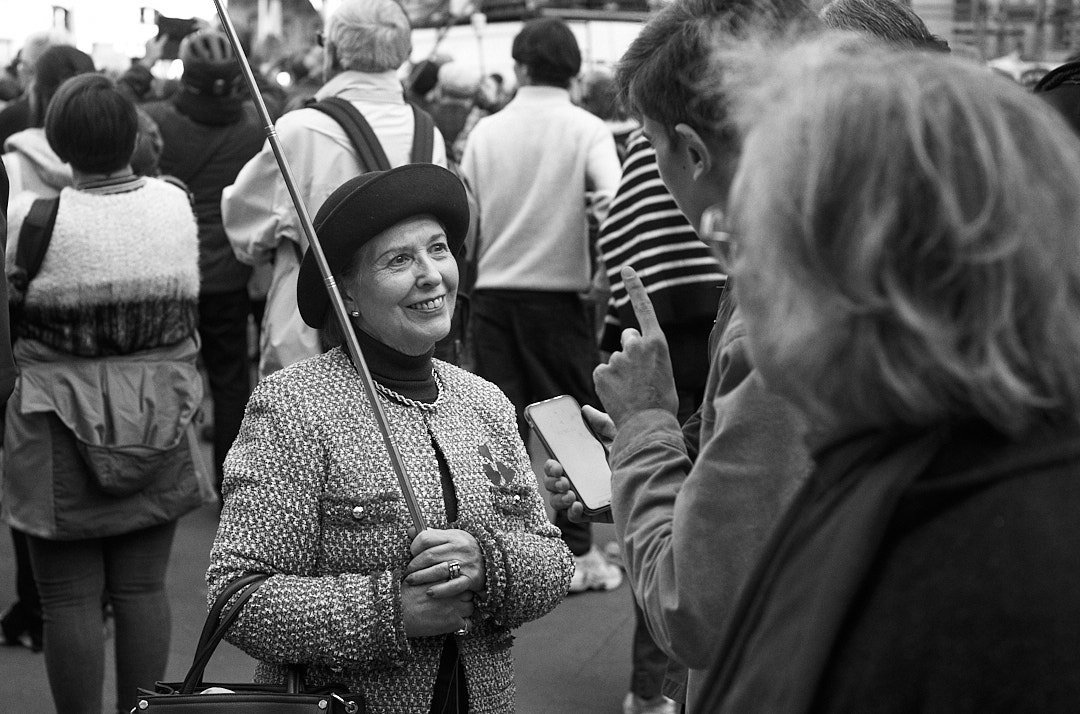
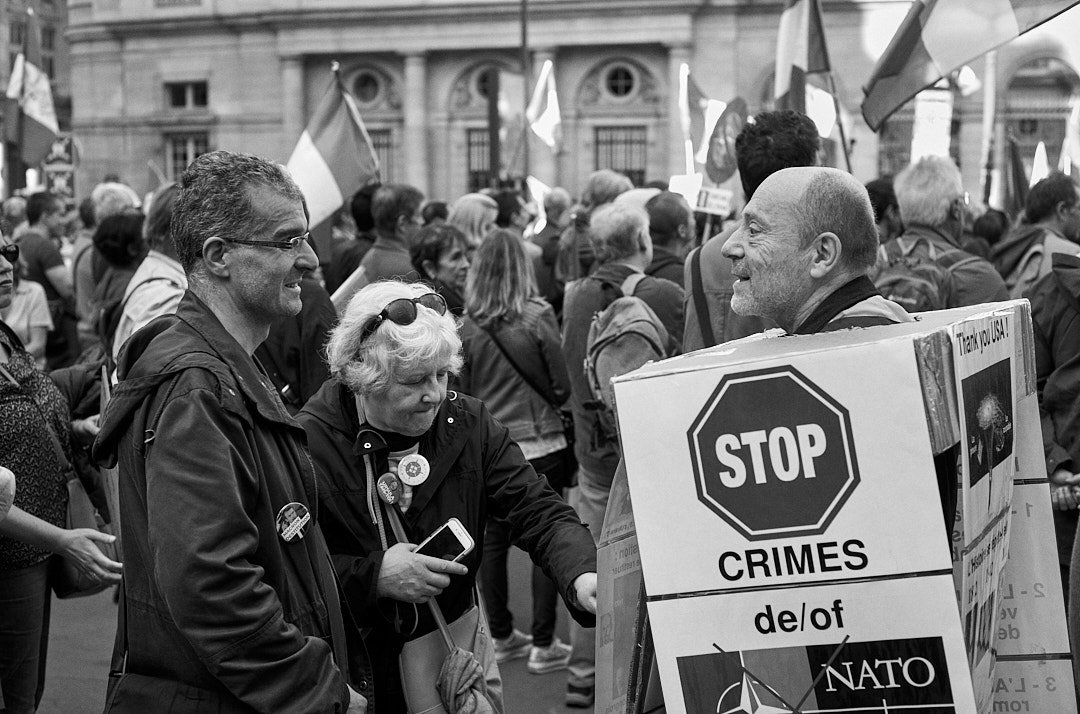
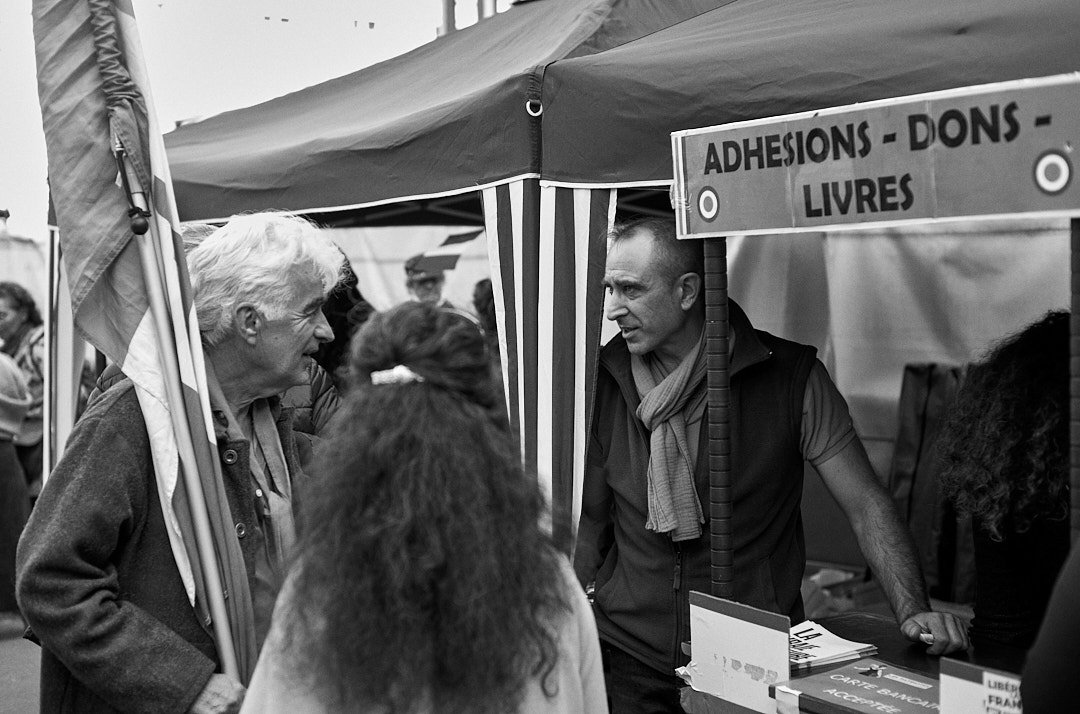
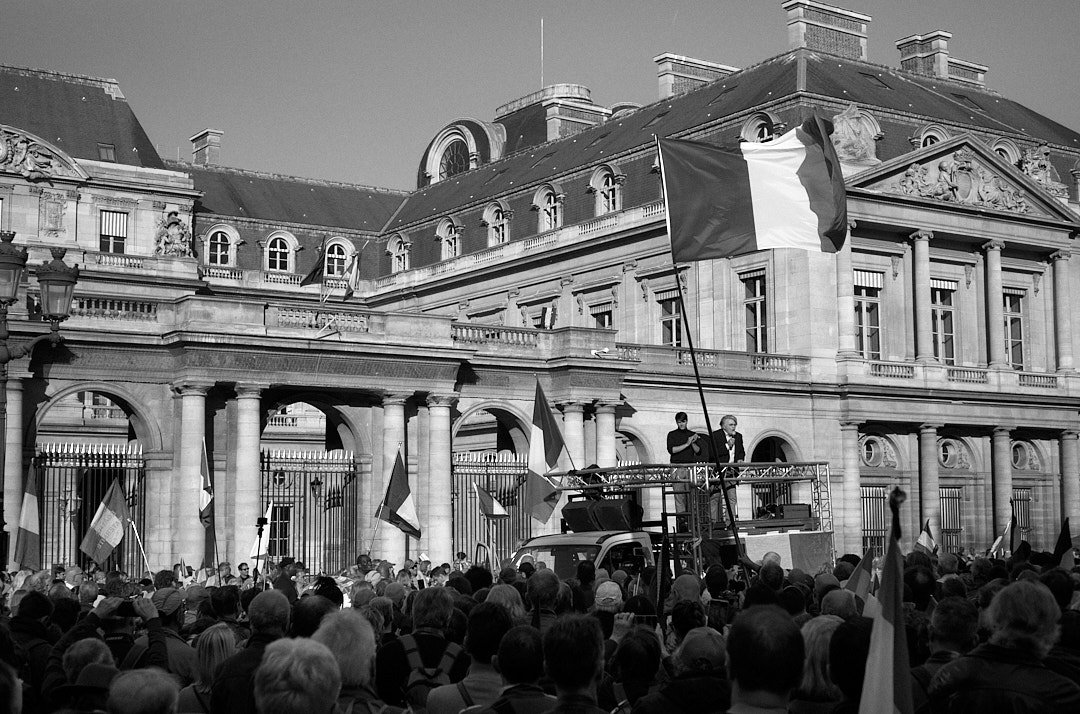
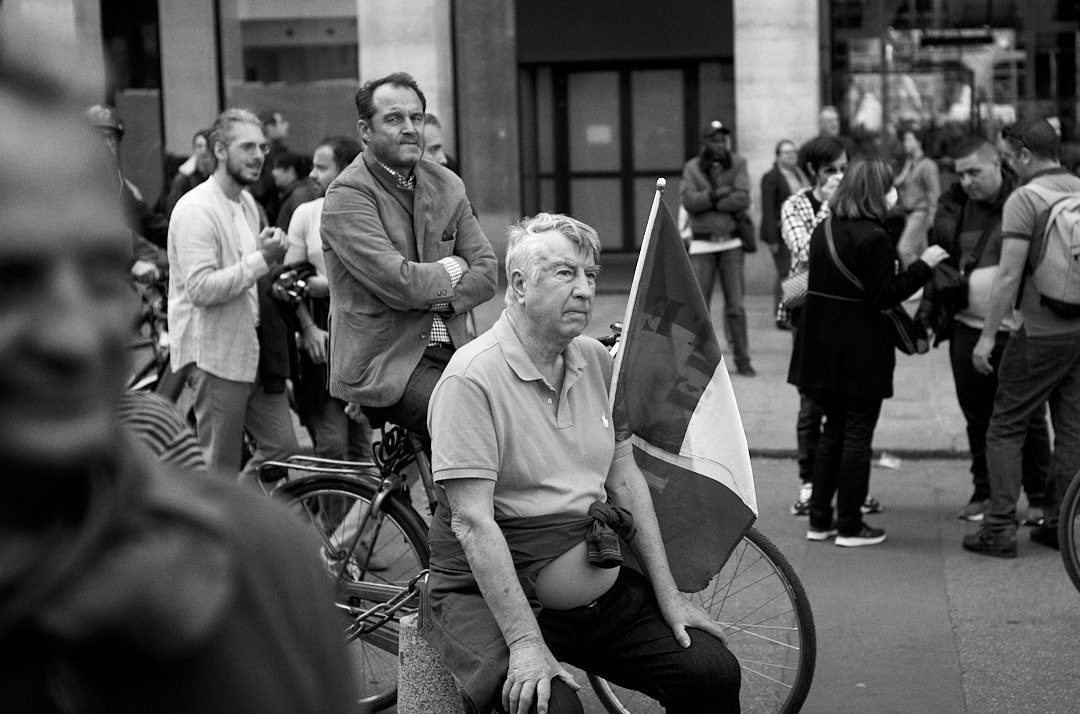
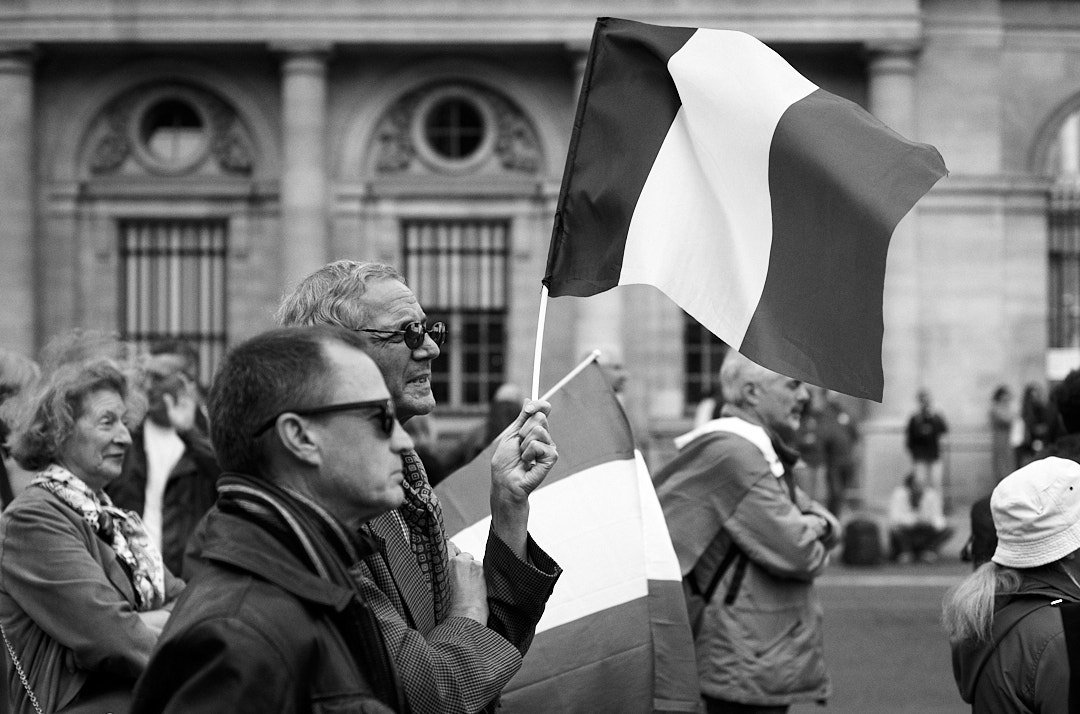
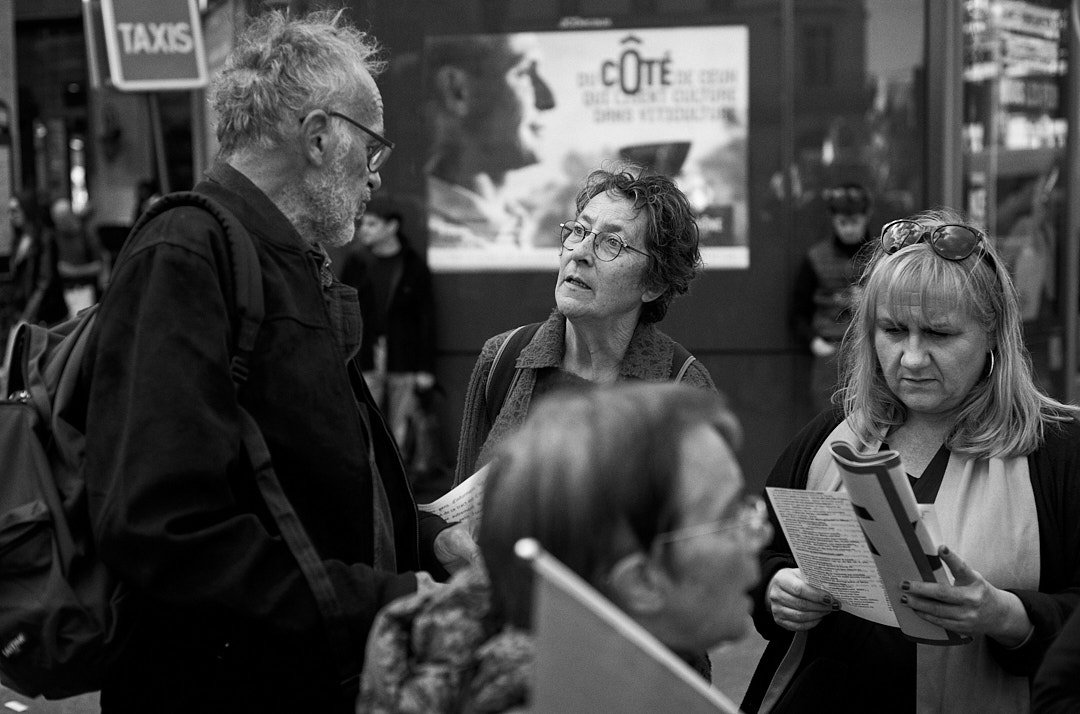

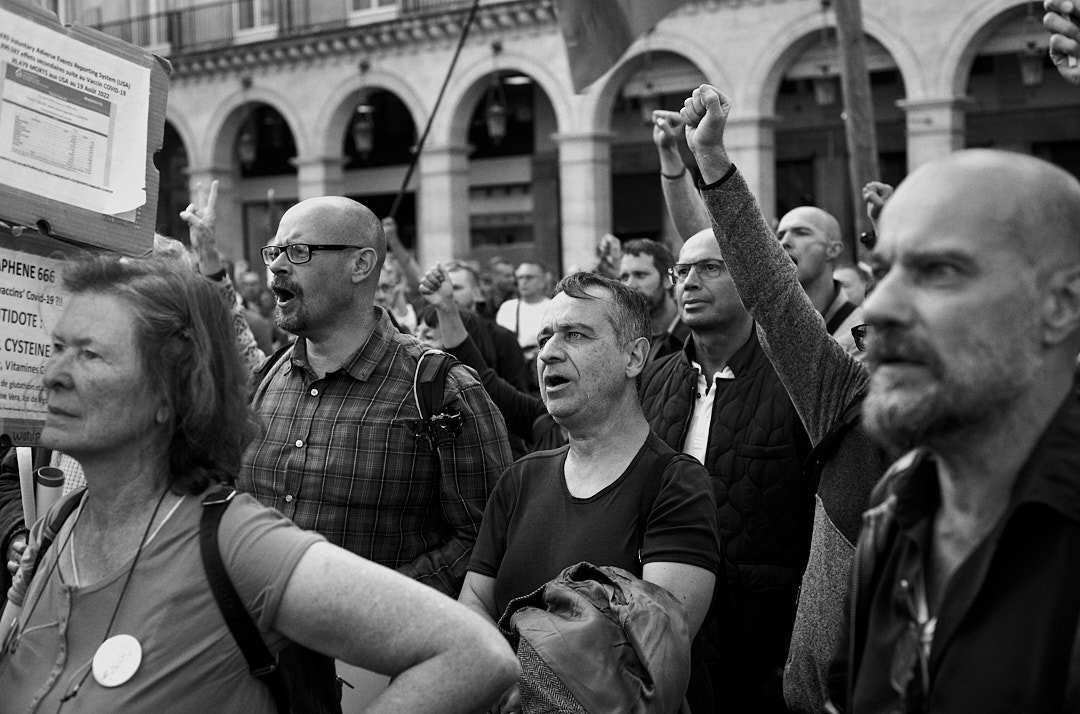
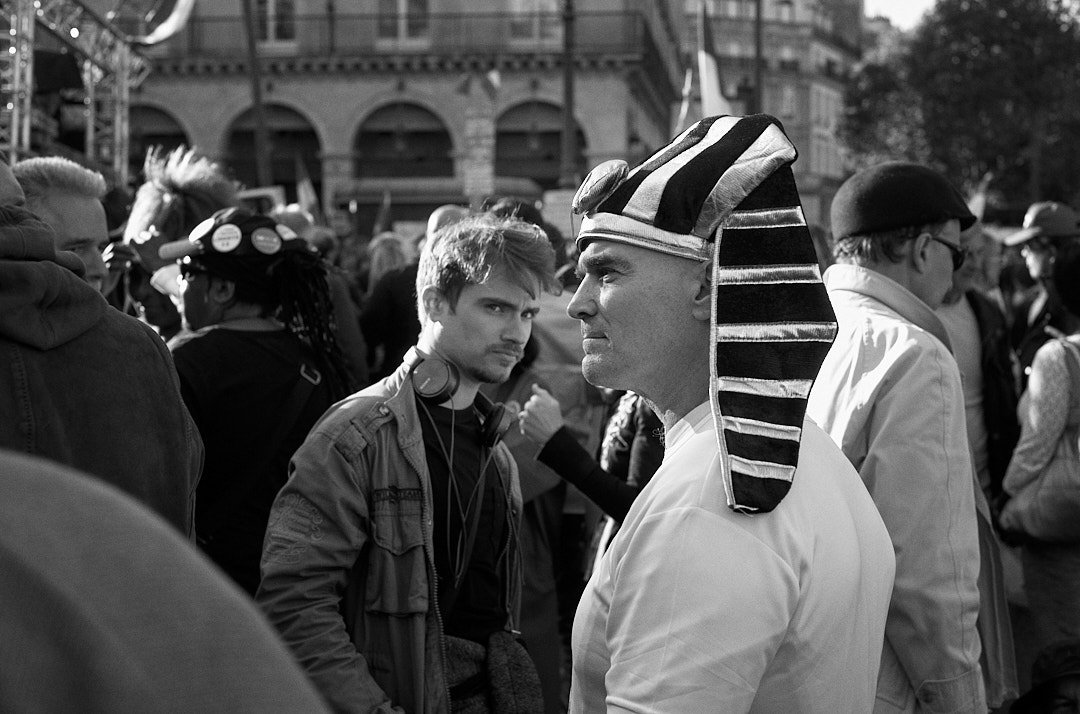
It's not just the US and England with people that make you scratch your head and ask why. Here is a fairly small group (even though the photos make the crowd look bigger due to them being tightly packed in a small area near the Louvre) that are calling for a "Frexit", their equivalent of Britains "Brexit". If this were in the 'barely' United States, they would be wearing red hats with MAGA logos, lined with tinfoil (just in case) and making bigoted claims in English as opposed to those I understood in French.
It's interesting that the crowd is similar to the US in one other way too. It's composed of a varied group of white people. As ridiculous as it seems and as small as it is, it's still something to watch. Trump at first couldn't fill a conference room without paying for extra bodies. With enough media attention he eventually drew real crowds of people just wanting the US to return to its pre civil war roots for the good of the nation. Clowns have a scary reputation for a reason.
A sincere smile works wonders
The moral of the story would seem to be that smiles open doors that otherwise may be closed. Smiling more never hurt anyone. It makes you feel good at the least and makes others feel good too. Point 2 (or 1a) is that it doesn’t hurt to talk to strangers.
As the sun was going down and I was looking for a few last shots before returning to my hotel room, I walked to Le Vieux Port knowing that there would still be a throng of people about. Some on their way somewhere while others sat, legs dangling over the water, enjoying exactly where they were. There were a lot of people along the edge of the port, enjoying both the declining sun and temperature.
It’s both beautiful and relaxing so there is no wonder why people are always there (at least in the warm months).
I walked around and photographed many people from many angles. Mostly trying not to be noticed. As I was framing this family in my viewfinder, the mom looked over at me.
What to do? I did what I always do, I smiled. As often happens, she smiled back. It’s a human thing. People (not all) usually return a smile when smiled at. At least they do when it’s sincere.
I thought for a moment to walk away but instead asked her if she would mind if I photographed her and her family in that beautiful light. Most of the exchange was non verbal since my French was as limited as her English. I’m very happy I did. She seemed pleased as well.
The moral of the story would seem to be that smiles open doors that otherwise may be closed. Smiling more never hurt anyone. It makes you feel good at the least and makes others feel good too. Point 2 (or 1a) is that it doesn’t hurt to talk to strangers.
Ask and ye shall receive goes the old saying.
What you receive may be a “No” but it equally could be a “Yes”. Your “Yes” count definitely goes up with a smile.
Most of my street photography tends to be people going about their lives unaware of me. I do love to take portraits of all kinds though. Street portraits are rewarding. They can lead to both wonderful images and meeting people.
The people you meet on the street make it worth it.
Walking around Marseille the other day photographing some street art, a man across the street asks if I’ll make a photo of him. Who am I to say no?
I was taking a walk around Marseille the other day (I love that I can say that since I live in the south of France now), photographing some street art in one of my favorite parts of town when a man across the street asks if I’ll make a photo of him. Who am I to say no? I took the portrait you see here fairly quickly and then we started talking. It turns out he’s from the Ivory Coast but had moved to Ukraine. Once Ukraine was invaded by Russia he moved to Marseille. Not one to be content with the first answer, I asked what brings a man from the Ivory Coast to Ukraine. It turns out he is a professional footballer and was playing there. Once the war started he moved out of harms way to the very interesting and diverse city on the Mediterranean. This wasn’t my only encounter or photo but it was one of the more memorable. Another will come shortly with it’s own backstory. A bientôt! (see you soon).
The Best Street photography lens is the one on your camera!
I could have easily changed but I didn’t. Why? First, I would have missed everything that happened while I was gone and I didn’t like that thought. Second, I firmly believe you can make just about anything work if you try.
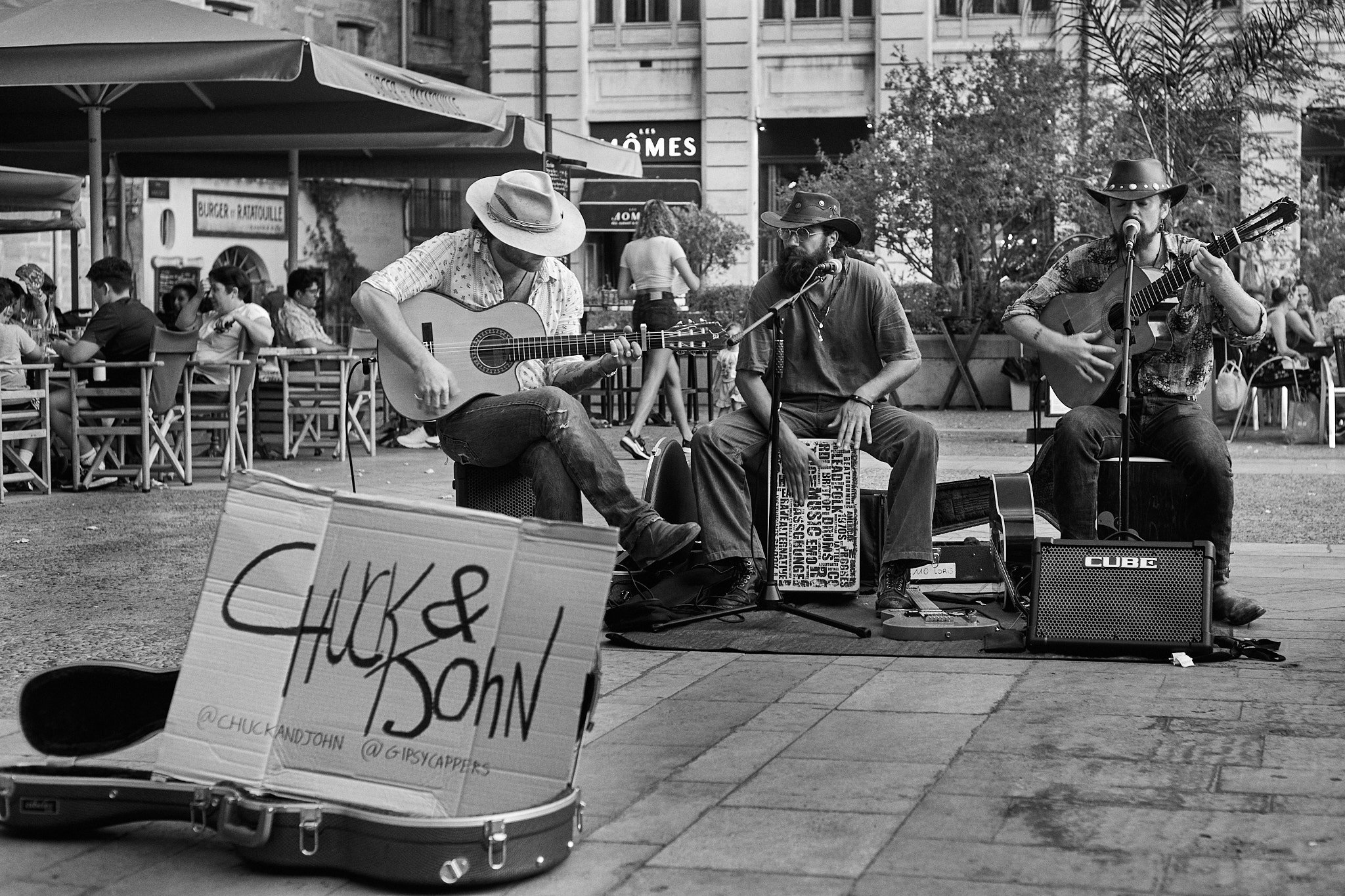


I’ll start this with the back story and end with photography wisdom. Here we go. I was washing dishes in our apartment while listening to a podcast for beginning French when my wife came up to me and said I should check out the band in the square right outside our window. I finished the last dish (if there were more I may have left them for later) and walked over to have a listen. They were really good. I asked my wife to join me for a glass of wine in the square so I could enjoy the music with my favorite person over a nice glass of wine and of course do a little street photography. This is one of the reasons we moved here in the first place. Live music is common all over town. In our square it’s not only daily, it can be multiple times a day. It is one of the things lacking back in Phoenix.
On to the photography. I almost always walk around with a single camera and a single focal length lens. This time was no exception. I thought about it for a half second and decided that I’d use a 50mm. My go to is often a 35 but I thought I’d go for a little extra reach. That plan was perfect until we got downstairs. As happens, I second guessed myself and thought I should have gone a bit wider with the 35mm. I live less than a minute away.
I could have easily changed but I didn’t. Why? First, I would have missed everything that happened while I was gone and I didn’t like that thought. Second, I firmly believe you can make just about anything work if you try. I have a built in zoom of course. My feet. I walk back and forth as needed. If I can’t get as wide as I want then I just adjust to a different view and get a tighter shot.
The more you learn to use what you have, improvise and adjust, the less likely you are to miss things due to not having what you wish you had. Keeping your gear simple, especially on the street keeps you tuned into what’s going on and I makes you better in a pinch.
If you always have an assortment of gear then what happens when you don’t? Do you just not take the shot and describe the scene that got away? I hope not.
Walking around on the street with a lot of gear has other drawbacks too. One is that (in my personal experience) I feel like I constantly have the wrong lens mounted. I keep wondering if I should change it. That nagging doubt gets in the way of my mental clarity.
Another is changing lenses. If something happens during a lens change then it’s better if you hadn’t seen it because its gone. You also lose the anonymity if you are walking around with a big bag full of gear and a big camera around your neck.
Lastly, you stick out as a mark for the nefarious street based camera traders. The kind that take your gear off of you for free and find someone else willing to pay for it.
Remember, this is based on my experience and observations. You may feel completely different. Cool. Get outside and don’t forget your camera!
Another sunny day in Paris
While the rally was getting ready to go this young skater/artist decided to use the time decorate her board. I couldn't help but notice the strange juxtaposition of her casually marking up her deck while a wall of cops prepared for violence (that didn't occur). Having a camera and being curious can be rewarding. It has led me into places and conversations I certainly would otherwise have missed. Vive la France! Vive la démocratie!
Just another sunny, beautiful day in Paris. The reality of course is that sunny days in Paris, while not unknown, are not the norm. Similarly, protests and rally's can be found with equal if not greater frequency. The French are not known for sitting quietly and letting life happen. They exercise their free speech out in the open. On this particular day while looking for a particular gallery with my family I saw a LOT of police activity. Being the curious type I left the family in the gallery line and followed the police and found a rally setting up. It was apparently to protest police brutality. Police in riot gear everywhere. Shields, pepper spray, tear gas launchers, batons and of course automatic weapons. I felt like i was home except that I couldn't understand exactly what was being chanted and I couldn't participate in any discussions (my french is very sub par for now). Democracy is messy but one of it's advantages over autocracies is that it gives you a better understanding of what your population is thinking and feeling. If you were going to invade your neighboring country you'd be better off knowing if your military and population were actually on your side or just doing it because they are scared of their leader. A healthy democracy provides for that. It's a feature and not a problem.
While the rally was getting ready to go this young skater/artist decided to use the time decorate her board. I couldn't help but notice the strange juxtaposition of her casually marking up her deck while a wall of cops prepared for violence (that didn't occur). Having a camera and being curious can be rewarding. It has led me into places and conversations I certainly would otherwise have missed. Vive la France! Vive la démocratie!
Street photography in Paris, revisiting the old
It's just to say we all miss things early and should go back and re-examine the things we didn't like in the past. You may just discover some of them are your new favorite things. Street photography wisdom.
Here is an image from a few years ago, moments after France beat Croatia in the World Cup Final. How did I never post this before? It's interesting when you go back through past images and something jumps out at you that you had overlooked multiple times before. Why is that? It could be that you were burnt out looking through a ton of almost perfects, goods and flat out "why did I take that"s. It could be that you had a certain thing/aesthetic in mind then and the current standout image didn't hit that mark. Another option that I think applies is growth in our vision. Let me expand on the last one.
When I was a younger person who had seen and experienced less of the world and viewed fewer works of art. I had a narrower view of good and bad. I looked at things I marvel over today with a different sense of wonder. I wondered how can anyone like that? I loved the easy stuff such as Rembrandt and Norman Rockwell (not at all similar) for painting. I didn't know anything at all about Picasso or Pollock. I loved Leibovitz and Karsh's photography and didn't understand the work Frank or Fink. I liked mixed drinks but couldn't understand why anyone would drink scotch on purpose. What changed? I did. I kept an open mind and tried new things. I met new people, read new books, viewed more art and I even determined to learn more about scotch to see why it was so well regarded. The result is I like a lot more things than I used to. I stay curious and continue to learn and grow. There are many people in the world who stop being curious early. They pick a few things they like and never change. I know they think of it as a virtue but I can only feel sorry for them (my opinion). They miss so much.
Look back at images you created over the months and years. Look at them with fresh eyes. It is almost a given that you will find something you missed before. What is interesting of course is that you noticed it and photographed it in the first place. You subconsciously knew it was good but consciously you weren't ready to embrace it. It was an acquired taste that you hadn't yet acquired. I feel almost embarrassed when I think back on my view of many things that I currently love. None of this of course is to say that the attached image is a masterpiece. It's just to say we all miss things early and should go back and re-examine the things we didn't like in the past. You may just discover some of them are your new favorite things.


